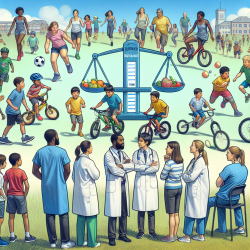Introduction
As practitioners dedicated to enhancing the lives of children, understanding the nuances of adolescent health issues is crucial. The research article "On a Different Page! Perceptions on the Onset, Diagnosis, and Management of Type 2 Diabetes Among Adolescent Patients, Parents, and Physicians" offers invaluable insights into the complexities of managing Type 2 Diabetes (T2D) in adolescents. This blog aims to distill the key findings of this study and provide actionable strategies for practitioners to improve their practice and outcomes for young patients.
Understanding the Challenges
The study highlights a critical gap in awareness and understanding of T2D symptoms and risk factors among adolescents and their parents. Despite experiencing common symptoms, many adolescents and parents were surprised by the diagnosis. This disconnect underscores the need for improved education and awareness initiatives.
Practitioners can play a pivotal role in bridging this gap by:
- Enhancing patient and family education on T2D symptoms and risk factors.
- Implementing routine screenings for at-risk adolescents, particularly those with obesity or a family history of diabetes.
Fostering Collaborative Care
The study reveals differing perceptions among adolescents, parents, and physicians regarding T2D management. While adolescents and parents focus on lifestyle changes post-diagnosis, physicians emphasize the importance of addressing social determinants of health and ensuring access to comprehensive care.
To foster a more collaborative approach, practitioners should:
- Encourage open communication between all parties involved in the adolescent's care.
- Integrate family-centered care models that involve parents and adolescents in decision-making processes.
- Advocate for resources that address social determinants of health, such as access to nutritious foods and healthcare services.
Leveraging Data for Better Outcomes
Data-driven decision-making is essential in managing chronic conditions like T2D. The study suggests that enhancing electronic health records (EHR) with comprehensive data on T2D symptoms and management can improve care outcomes.
Practitioners can leverage data by:
- Utilizing EHRs to track patient progress and adjust treatment plans accordingly.
- Participating in research initiatives that contribute to a deeper understanding of T2D in adolescents.
Encouraging Further Research
While this study provides a foundational understanding of the perceptions surrounding adolescent T2D, further research is needed to explore effective interventions and educational strategies. Practitioners are encouraged to engage in or support research efforts that aim to close the gaps identified in this study.
Conclusion
By implementing the insights from this research, practitioners can enhance their approach to managing T2D in adolescents. Through education, collaboration, and data-driven strategies, we can work towards better health outcomes for our young patients.
To read the original research paper, please follow this link: On a Different Page! Perceptions on the Onset, Diagnosis, and Management of Type 2 Diabetes Among Adolescent Patients, Parents, and Physicians.










